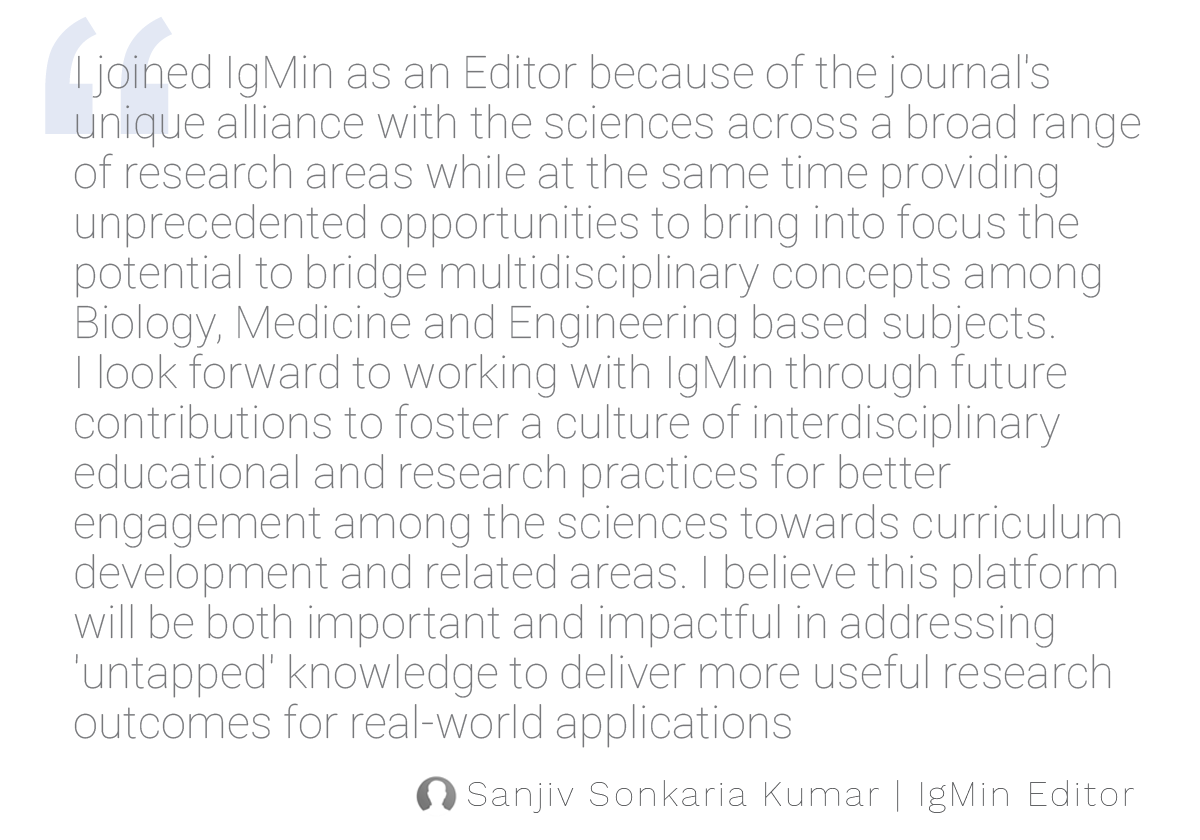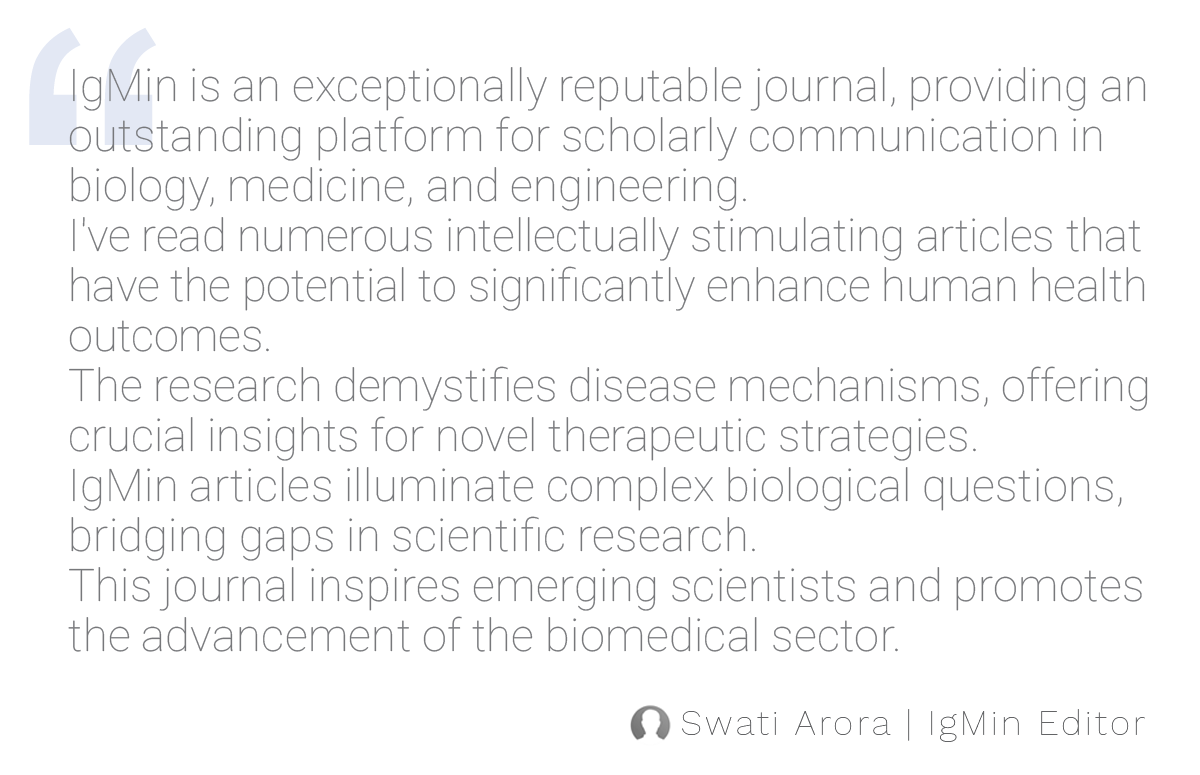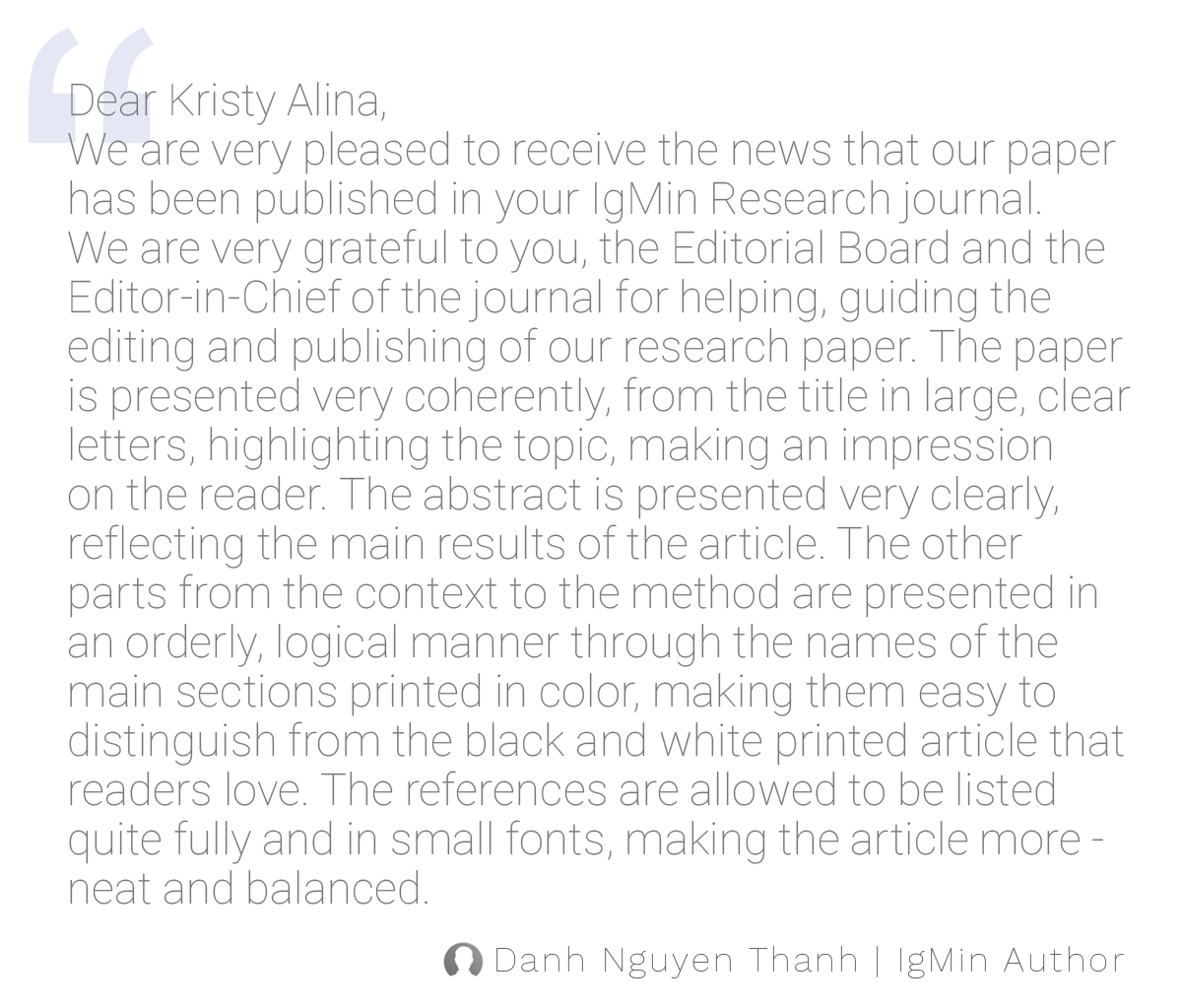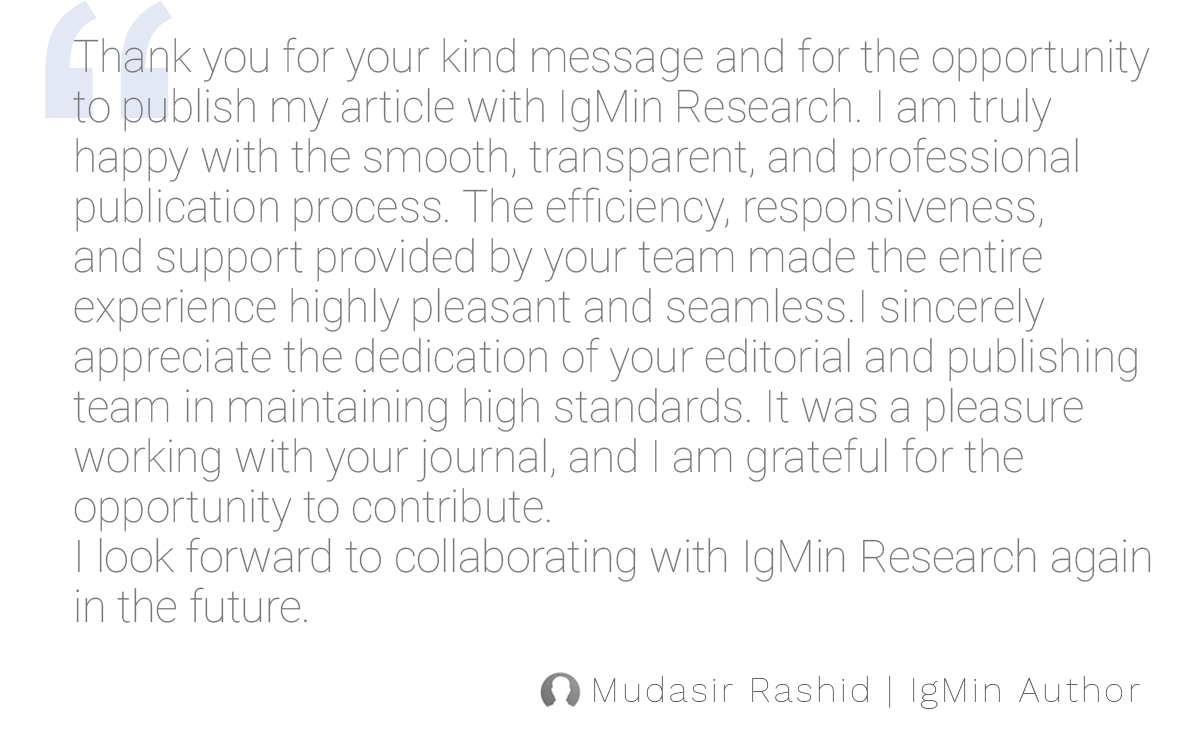Word Count Policy
The "Word Count Policy" is a fundamental aspect of IgMin Research - A BioMed & Engineering Open Access Journal, ensuring consistency and coherence in published articles. As a platform dedicated to fostering scientific communication and promoting multidisciplinary research, adhering to word count guidelines becomes crucial in facilitating effective and impactful dissemination of knowledge within the scientific community. This policy outlines the maximum and minimum word limits for different types of articles published in the journal, underscoring the importance of clear and concise communication in scholarly publications.
Research Articles
Research Articles form the backbone of IgMin Research - A BioMed & Engineering Open Access Journal, representing the primary channel for researchers to disseminate original findings and contribute to scientific advancement. As a multidisciplinary platform, the journal welcomes diverse research topics that span the various branches of Science, Technology, Engineering, and Medicine . To ensure high-quality contributions and maintain the journal's standards, the "Word Count Policy" sets specific guidelines for word limits in Research Articles.
- Word Count Range: Research Articles should adhere to a word count range of approximately 4000 to 6000 words. This range is carefully determined to strike a balance between presenting comprehensive insights into the study and avoiding unnecessary verbosity that may distract readers from the central message. Abiding by this range allows authors to concisely communicate their research while providing sufficient depth to convey the methodology, results, and implications of their study effectively.
- Abstract: The Research Article should begin with a well-crafted abstract, summarizing the study's objectives, methodology, main results, and conclusions. The abstract serves as a succinct overview, enabling readers to quickly assess the article's relevance to their own research interests. It should encapsulate the essence of the research, offering a clear and enticing glimpse into the study's significance.
- Introduction: Following the abstract, the Introduction provides essential background information, setting the context for the research. It should introduce the research problem or question, explain its relevance and significance in the broader field, and review pertinent existing literature. The introduction should aim to engage readers, creating an understanding of why the research is crucial and how it builds upon the existing knowledge.
- Methodology: The Methodology section outlines the research design, data collection methods, and analytical procedures employed in the study. Authors should provide sufficient detail to enable reproducibility and evaluation of the research. However, unnecessary technical details should be avoided to maintain conciseness. The methodology should be presented logically and transparently, ensuring that readers can assess the validity and reliability of the research.
- Results: In the Results section, authors present their findings based on the analysis of the collected data. The results should be presented objectively, with clear visual aids such as tables, figures, and charts to enhance comprehension. Authors should avoid discussing the implications of the results in this section and focus solely on the presentation of empirical data.
- Discussion: The Discussion section is the heart of the Research Article, where authors interpret the results and relate them to the research objectives and the existing body of knowledge. This section should explore the significance of the findings, address any limitations, and compare the results with previous studies. Authors may also suggest potential applications, propose avenues for future research, and emphasize the broader implications of their work.
- Conclusion: The Conclusion summarizes the key findings of the study, reiterates their importance, and restates the implications for the field. It should avoid introducing new information and remain focused on the core messages presented in the research. The conclusion provides closure to the article, leaving readers with a clear understanding of the study's contributions and significance.
- References: A properly formatted list of references should be provided at the end of the Research Article. Citations throughout the article should follow a consistent citation style (e.g., APA, MLA, Chicago) to ensure accuracy and credibility. Authors must acknowledge the contributions of previous research and respect intellectual property rights.
In summary, Research Articles in IgMin Research - A BioMed & Engineering Open Access Journal follow a structured and coherent format, adhering to the specified word count range. Authors are encouraged to present their original findings in a clear, concise, and objective manner, ensuring the scientific community's comprehension and potential for further exploration. Through adherence to the "Word Count Policy" and the rigorous review process, the journal endeavors to maintain its reputation as a valuable platform for disseminating groundbreaking research across diverse fields of study.
Review Articles
Review Articles play a critical role in IgMin Research - A BioMed & Engineering Open Access Journal by consolidating existing knowledge, critically analyzing research trends, and presenting comprehensive insights within a specific domain. These articles are instrumental in shaping the scientific landscape, guiding researchers, and facilitating interdisciplinary understanding. To uphold the journal's commitment to excellence and intellectual rigor, authors are encouraged to adhere to a word count of approximately 5000 to 8000 words for Review Articles.
Elaboration of the Process Involved in Writing Review Articles:
- Choosing the Topic: The process of writing a Review Article begins with selecting an appropriate topic that aligns with the journal's scope and the current interests of the scientific community. Authors should identify a subject that is relevant, significant, and has ample literature for analysis. The chosen topic should address a specific research question or theme to guide the structure and focus of the Review Article.
- Literature Review: Conducting a thorough literature review is crucial for a successful Review Article. Authors should explore reputable databases, libraries, and research journals to identify relevant studies, publications, and academic works related to the chosen topic. The literature review aims to cover both classical and recent literature, ensuring a comprehensive understanding of the subject's historical development and its current status.
- Outlining the Review Article: Once the literature review is complete, authors should outline the Review Article's structure to maintain coherence and flow. The outline typically includes sections such as the abstract, introduction, main body (divided into relevant subsections), conclusion, and references. Each section should have a clear purpose and contribute to the overall objective of the Review Article.
- Abstract: The abstract serves as a concise summary of the Review Article, highlighting its scope, main objectives, and key findings. It should provide a clear overview of the literature reviewed and the major conclusions drawn from the analysis.
- Introduction: The introduction sets the stage for the Review Article by providing context and background information on the chosen topic. It should define the research question or theme addressed in the article and explain its significance in the broader scientific context. Additionally, the introduction should present the scope and objectives of the review to guide readers through the subsequent sections.
- Main Body: The main body of the Review Article is divided into coherent sections, each focusing on specific aspects or subtopics related to the chosen theme. Each section should be structured logically, presenting the literature in a cohesive manner. Authors should critically analyze and synthesize the findings of different studies, highlighting key contributions, methodological approaches, controversies, and consensus points. The main body should also identify gaps in the literature and areas that require further exploration.
- Conclusion: The conclusion provides a comprehensive summary of the Review Article, emphasizing the key findings, insights gained, and contributions to the field. It should reiterate the significance of the chosen topic and its relevance to current research trends. Authors should also propose potential avenues for future research and suggest practical implications arising from the review's findings.
- References: Accurate and consistent referencing is crucial for a Review Article. Authors should adhere to the journal's citation style guidelines and provide complete and properly formatted references for all cited works. The reference list should include a diverse range of sources, comprising books, research articles, monographs, and other relevant publications.
- Peer Review and Revisions: After completing the first draft, authors should consider seeking feedback from colleagues or mentors to ensure the accuracy and rigor of the Review Article. Peer review provides valuable insights, identifies potential weaknesses, and ensures that the article meets the journal's quality standards. Authors should revise the manuscript based on the feedback received, ensuring that it addresses all comments and concerns raised during the peer review process.
- Ethical Considerations: Throughout the writing process, authors should adhere to ethical principles, including proper attribution of sources, avoiding plagiarism, and obtaining permission for the use of copyrighted materials, if necessary. The Review Article should also disclose any potential conflicts of interest and acknowledge funding sources, if applicable.
In conclusion, the process of writing a Review Article for IgMin Research - A BioMed & Engineering Open Access Journal involves meticulous planning, comprehensive literature review, critical analysis, and objective presentation of findings. By adhering to the journal's word count guidelines and following a well-structured approach, authors can contribute significantly to the scientific community by disseminating knowledge, identifying research gaps, and guiding future investigations in their respective fields.
Editorials and Perspectives
Overview: Editorials and perspectives are a crucial component of IgMin Research - A BioMed & Engineering Open Access Journal, offering a platform for distinguished experts in various scientific fields to share their insights, opinions, and reflections on significant scientific issues. These articles provide a subjective viewpoint, encouraging authors to express their perspectives and engage in critical discourse. Through Editorials and Perspectives, the journal aims to foster intellectual exchange, stimulate thought-provoking discussions, and promote a deeper understanding of emerging trends and challenges in the scientific community.
Submission Process
- Call for Contributions: IgMin Research periodically issues a call for editorials and perspectives, inviting experts to contribute their viewpoints on timely and relevant scientific topics. Alternatively, researchers can proactively propose their ideas to the editorial team, suggesting topics that align with the journal's scope and objectives.
- Editorial Review: Once the submissions are received, the journal's editorial team initiates a comprehensive review process. This review is conducted by experienced editors who assess the articles for alignment with the journal's focus, relevance, originality, and adherence to ethical guidelines.
- Selection Criteria: The editorial team considers various factors when selecting editorials and perspectives for publication. The articles should offer unique perspectives, introduce thought-provoking ideas, and address current or emerging issues in the scientific community. They should also be written in a clear, concise, and engaging manner, catering to a diverse readership.
Content Guidelines
- Clarity of Purpose: Editorials and Perspectives should begin with a clear statement of the author's purpose or argument. The introduction should set the context and explain the significance of the chosen topic in the broader scientific landscape.
- Supporting Arguments: Authors are encouraged to present well-reasoned arguments backed by reliable evidence, data, and references. The incorporation of relevant research findings and statistical data can strengthen the article's credibility and impact.
- Balanced Analysis: While Editorials and Perspectives allow for subjective viewpoints, they should strive for a balanced analysis. Authors should acknowledge counterarguments, potential limitations, and alternative perspectives, thus contributing to an inclusive and constructive scientific discourse.
- Jargon and Accessibility: Authors should be mindful of their language and avoid excessive jargon or technical terminology. The goal is to make the article accessible to a broad readership, including researchers from different disciplines and interested individuals outside academia.
- Engaging Narrative: Editorials and Perspectives should be engaging and well-structured, capturing the readers' attention from the beginning. The articles should flow logically, leading readers through the author's thought process and concluding with a succinct summary of the main points.
Review and Editing
- Peer Review: Once the editorial team identifies potential Editorials and Perspectives for publication, they undergo a peer-review process. Peer reviewers, who are experts in the respective field, assess the articles for clarity, coherence, and scientific merit.
- Feedback and Revisions: Authors receive feedback from peer reviewers, addressing any concerns or suggestions for improvement. Authors are encouraged to carefully consider the feedback and make necessary revisions to enhance the quality and impact of their work.
Publication and Dissemination
- Publication: Upon successful review and revision, accepted Editorials and Perspectives are prepared for publication. They are professionally formatted, and any necessary copyediting is done to ensure clarity and adherence to journal guidelines.
- Online Publication: The published Editorials and Perspectives are made available on the journal's website, providing immediate access to the scientific community and the public. This online platform ensures rapid dissemination and facilitates engagement with the articles.
- Promotion and Visibility: The journal's editorial team actively promotes published Editorials and Perspectives through various channels, including social media, newsletters, and academic databases. This effort increases the visibility of the articles, inviting a broader readership and encouraging scholarly discussions.
Impact and Contribution
- Intellectual Exchange: Editorials and Perspectives play a significant role in fostering intellectual exchange and critical thinking within the scientific community. These articles offer diverse perspectives, stimulating conversations and debates that contribute to the advancement of knowledge.
- Influencing Policy and Practice: Editorials and Perspectives have the potential to influence policy decisions, research agendas, and scientific practices. Policymakers, stakeholders, and researchers often refer to these articles to gain insights into emerging issues and novel solutions.
- Engagement and Collaboration: By providing a platform for experts to share their perspectives, Editorials and Perspectives encourage collaboration among researchers from different disciplines. This interdisciplinary engagement can lead to innovative solutions and novel research directions.
In conclusion, Editorials and Perspectives serve as a cornerstone of intellectual exchange in IgMin Research - A BioMed & Engineering Open Access Journal. Through a rigorous review process and adherence to content guidelines, these articles present subjective viewpoints while maintaining a balanced and engaging narrative. By promoting critical discussions, fostering collaboration, and influencing scientific practice, Editorials and Perspectives play a vital role in advancing knowledge and promoting multidisciplinary research within the scientific community.
Letter to the Editor
"Letter to the Editor" is a unique and valuable section in IgMin Research - A BioMed & Engineering Open Access Journal, providing readers with an opportunity to engage in constructive discussions related to previously published articles. It serves as a platform for scholarly dialogue, allowing researchers to voice their perspectives, raise queries, and offer insights that contribute to the ongoing scientific discourse. This section aims to foster an open and collaborative environment within the scientific community, encouraging the exchange of ideas and facilitating knowledge enrichment.
Process Involved in Submitting a Letter to the Editor:
- Read the Original Article: Authors interested in submitting a Letter to the Editor should begin by thoroughly reading the original article published in IgMin Research. Understanding the content and context of the article is crucial to formulating meaningful and relevant points for discussion.
- Crafting the Letter: The next step involves crafting the letter itself. The letter should be concise, well-structured, and to the point. Authors are encouraged to adhere to the prescribed word count of approximately 500 to 1000 words. It should be written in a clear and objective tone, focusing on the scientific aspects of the article being addressed.
- Introduction: The letter should start with a courteous and respectful introduction, addressing the editor of the journal. The author should identify themselves and briefly state their academic or professional affiliation, if applicable.
- Reference to the Article: In the opening paragraphs, authors should explicitly reference the original article they are responding to. It is essential to include the article's title, authors, and publication details to ensure clarity and facilitate the editorial team's verification process.
- Specific Points of Discussion: The body of the letter should be dedicated to specific points of discussion. Authors can raise queries, seek clarifications, offer alternative interpretations of results, or present additional data that may contribute to the understanding of the original article. It is crucial to maintain a constructive and objective tone while presenting these points.
- Citations and Evidence: To support their arguments and enhance the credibility of their letter, authors are encouraged to provide references to relevant scientific literature. These citations should be accurately formatted following the journal's citation style guidelines.
- Acknowledgment of Strengths: While it is essential to raise critical points for discussion, authors should also acknowledge the strengths and contributions of the original article. This demonstrates a balanced and fair approach to the discussion and fosters a positive scholarly atmosphere.
- Submission Process: Authors can submit their Letters to the Editor through the journal's online submission system. The platform will guide authors through the necessary steps, including providing information about the original article they are responding to and attaching their letter as a separate document.
- Editorial Review: Upon submission, the Letters to the Editor undergo a review process by the journal's editorial team. The review aims to ensure that the letter complies with the journal's guidelines, adheres to ethical standards, and offers meaningful contributions to the scientific discourse.
- Response from Authors of the Original Article: Once the Letter to the Editor is deemed suitable for publication, the editorial team may invite the authors of the original article to respond. This creates a constructive dialogue between the two parties and enriches the discussion further.
- Publication: Approved Letters to the Editor are published in a designated section of the journal, typically in the same issue as the article to which they are responding. The online publication of letters allows for wider dissemination and facilitates engagement from the broader scientific community.
In conclusion, "Letter to the Editor" is an integral section of IgMin Research - A BioMed & Engineering Open Access Journal that encourages scholarly exchange and collaboration. By providing readers with a platform to engage with previously published articles, the journal fosters an environment of open dialogue, critical thinking, and knowledge enrichment. Authors interested in contributing to this section should carefully adhere to the submission guidelines and present their arguments in a respectful, objective, and well-structured manner. Through this process, the journal endeavors to facilitate an ongoing and vibrant scientific discourse that benefits researchers, practitioners, and the broader society alike.
Book Reviews
Book Reviews play a vital role in IgMin Research - A BioMed & Engineering Open Access Journal by offering researchers an opportunity to critically evaluate and analyze scientific literature, monographs, and other relevant publications. The process of conducting a book review involves several key steps that ensure a balanced and informative assessment, providing readers with valuable insights into the book's content, contributions, and potential impact.
Step 1: Selection of the Book
The book review process commences with the selection of a book that holds relevance and significance within the chosen subject area. The journal's editorial team may identify books for review or accept book review proposals from researchers and experts in the field. The selected book should align with the journal's multidisciplinary focus and contribute to the advancement of knowledge in Biology, Medicine and Engineering fields.
Step 2: Familiarization with the Book
Once the book is selected, the reviewer thoroughly familiarizes themselves with its content. This involves reading the book in its entirety to gain a comprehensive understanding of the author's arguments, methodologies, and key findings. During this phase, the reviewer takes notes and highlights essential passages to refer to during the writing process.
Step 3: Contextualizing the Book
In the review, the book should be contextualized within the broader subject area or field of research. The reviewer provides relevant background information and identifies the book's significance in addressing current gaps or contributing to ongoing discussions within the scientific community.
Step 4: Summarizing the Book
The review should include a concise yet informative summary of the book's main points, arguments, and structure. This summary provides readers with a broad overview of the book's content and enables them to understand its key themes without reading the entire work.
Step 5: Analyzing the Book's Content
The core of the book review lies in its critical analysis of the book's content. The reviewer objectively evaluates the strengths and weaknesses of the book, assessing the effectiveness of the author's arguments, the soundness of the methodology employed, and the overall coherence of the book's structure. The analysis should be supported by specific examples and evidence from the book.
Step 6: Assessing the Book's Contribution
A critical aspect of the book review is assessing the book's contribution to the field of study. The reviewer evaluates the originality and innovation of the book's ideas and identifies how it enhances or challenges existing knowledge. This assessment helps readers gauge the book's significance and potential impact on the scientific community.
Step 7: Identifying the Target Audience
In the review, the reviewer should also identify the book's target audience. This includes researchers, students, or professionals in specific disciplines or interdisciplinary fields. Understanding the target audience helps potential readers determine the book's relevance to their interests and research goals.
Step 8: Writing the Review
The book review should be written in a clear, concise, and objective tone. The reviewer should avoid personal biases and provide an impartial evaluation of the book. The review should follow a logical structure, beginning with an introduction that introduces the book and its author, followed by a summary, analysis, and assessment of the book's contribution. Citations and references should be provided to support the reviewer's claims.
Step 9: Proofreading and Editing
Before submission, the reviewer should carefully proofread and edit the book review to ensure accuracy, clarity, and coherence. Paying attention to grammar, punctuation, and formatting helps maintain a professional and polished review.
Step 10: Submission and Publication
Once the book review is finalized, the reviewer submits it to the journal's editorial team for review and publication. The editorial team may conduct further evaluations and revisions before accepting the review for publication. Once published, the book review becomes a valuable resource for readers seeking insights into the book's content and scholarly contributions.
The process of conducting a book review for IgMin Research - A BioMed & Engineering Open Access Journal involves careful selection, familiarization, contextualization, summarization, analysis, and assessment of the book's content and contribution. By adhering to an informative and objective tone, book reviews offer readers a valuable resource to understand the book's significance, relevance, and potential impact within the scientific community. The book review process ensures that the journal maintains its commitment to scholarly rigor and excellence, fostering meaningful discussions and advancing knowledge in multidisciplinary Biology, Medicine and Engineering fields.
In conclusion, the "Word Count Policy" in IgMin Research - A BioMed & Engineering Open Access Journal is a foundational guideline to ensure clarity and effectiveness in scientific communication. By setting appropriate word count limits for each article type, the journal strives to facilitate knowledge exchange, promote interdisciplinary collaboration, and elevate the standard of research publications. Authors are encouraged to adhere to the word count guidelines to maximize the impact and reach of their research contributions, fostering a culture of concise, coherent, and impactful scientific discourse.
Why publish with us?
Global Visibility – Indexed in major databases
Fast Peer Review – Decision within 14–21 days
Open Access – Maximize readership and citation
Multidisciplinary Scope – Biology, Medicine and Engineering
Editorial Board Excellence – Global experts involved
University Library Indexing – Via OCLC
Permanent Archiving – CrossRef DOI
APC – Affordable APCs with discounts
Citation – High Citation Potential
Which articles are now trending?
Research Articles
- Contribution to the Knowledge of Ground Beetles (Coleoptera: Carabidae) from Pakistan
- Lifestyle and Well-being among Portuguese Firefighters
- Microgravity Employment in Archaeology – Available Experience and Future Perspectives
- Gaussian-Transform for the Dirac Wave Function and its Application to the Multicenter Molecular Integral Over Dirac Wave Functions for Solving the Molecular Matrix Dirac Equation
- Efficacy of Alternative Insecticides against Dusky Cotton Bug (Oxycarenus laetus) to Improve Yield Losses in Cotton Crops through Residue-based Bioassay
- Semiclassical Potential Function of B–B Interaction: Reduction to Integrable Form
Advertisement










